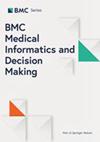基于机器学习的预后模型用于预测败血症-3 的 30 天死亡率
IF 3.3
3区 医学
Q2 MEDICAL INFORMATICS
引用次数: 0
摘要
败血症对住院病人,尤其是重症监护病房(ICU)的病人构成严重威胁。快速识别败血症对提高存活率至关重要。在预测结果方面,机器学习技术比传统方法更具优势。本研究旨在使用基于堆栈的元分类器开发一个预后模型,以预测来自 MIMIC-III 数据库的败血症-3 患者的 30 天死亡风险。研究分析了 4240 名败血症-3 患者,其中 783 人 30 天内死亡,3457 人存活。使用特征排序方法(包括极梯度提升(XGBoost)、随机森林和额外树)筛选出了 15 个生物标志物,并使用逻辑回归(LR)模型评估了它们各自的预测能力,同时采用五重交叉验证方法验证了预测结果。使用 SMOTE-TOMEK LINK 技术平衡数据集,并使用基于堆叠的元分类器进行 30 天死亡率预测。对模型的预测结果进行了SHapley加性解释分析。使用 LR 分类器,该模型的曲线下面积或 AUC 得分为 0.99。提名图为临床提供了生物标志物重要性的见解。堆叠元学习器 LR 分类器表现最佳,准确率为 95.52%,精确率为 95.79%,召回率为 95.52%,特异性为 93.65%,F1 分数为 95.60%。结合提名图,所提出的堆叠分类器模型可有效预测败血症患者的 30 天死亡率。这种方法有望对败血症病例进行早期干预并改善治疗效果。本文章由计算机程序翻译,如有差异,请以英文原文为准。
Machine learning-based prognostic model for 30-day mortality prediction in Sepsis-3
Sepsis poses a critical threat to hospitalized patients, particularly those in the Intensive Care Unit (ICU). Rapid identification of Sepsis is crucial for improving survival rates. Machine learning techniques offer advantages over traditional methods for predicting outcomes. This study aimed to develop a prognostic model using a Stacking-based Meta-Classifier to predict 30-day mortality risks in Sepsis-3 patients from the MIMIC-III database. A cohort of 4,240 Sepsis-3 patients was analyzed, with 783 experiencing 30-day mortality and 3,457 surviving. Fifteen biomarkers were selected using feature ranking methods, including Extreme Gradient Boosting (XGBoost), Random Forest, and Extra Tree, and the Logistic Regression (LR) model was used to assess their individual predictability with a fivefold cross-validation approach for the validation of the prediction. The dataset was balanced using the SMOTE-TOMEK LINK technique, and a stacking-based meta-classifier was used for 30-day mortality prediction. The SHapley Additive explanations analysis was performed to explain the model’s prediction. Using the LR classifier, the model achieved an area under the curve or AUC score of 0.99. A nomogram provided clinical insights into the biomarkers' significance. The stacked meta-learner, LR classifier exhibited the best performance with 95.52% accuracy, 95.79% precision, 95.52% recall, 93.65% specificity, and a 95.60% F1-score. In conjunction with the nomogram, the proposed stacking classifier model effectively predicted 30-day mortality in Sepsis patients. This approach holds promise for early intervention and improved outcomes in treating Sepsis cases.
求助全文
通过发布文献求助,成功后即可免费获取论文全文。
去求助
来源期刊
CiteScore
7.20
自引率
5.70%
发文量
297
审稿时长
1 months
期刊介绍:
BMC Medical Informatics and Decision Making is an open access journal publishing original peer-reviewed research articles in relation to the design, development, implementation, use, and evaluation of health information technologies and decision-making for human health.

 求助内容:
求助内容: 应助结果提醒方式:
应助结果提醒方式:


